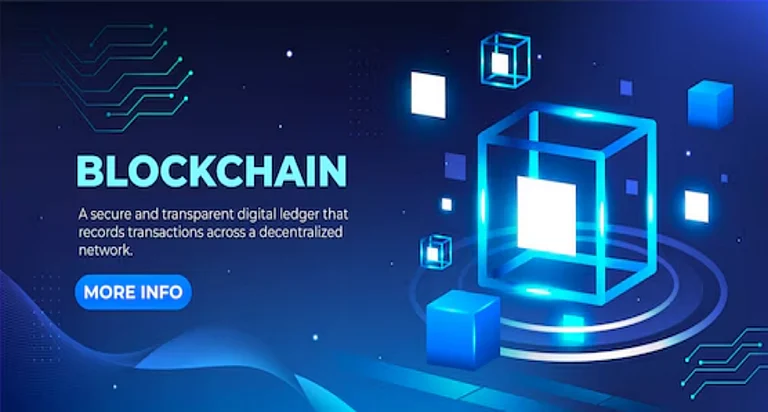In the contemporary digital era, technology is continuously reshaping how we transfer value and conduct money transactions. From cashless payments to online banking, traditional systems which are often slower and less secure are being replaced by digital solutions. In the face of such improvements, there's one technology that is a real game changer—blockchain.
Although blockchain is often related to digital currency, its usage extends far beyond the exchange of money. It's an innovative technology that makes things more secure, open, and middleman-less across many sectors. So, what is blockchain, and why is it being thought of as one of the greatest technological advancements of our times? Let's uncover its fundamentals in plain terms.
What is Blockchain?
At its core, blockchain is a decentralized digital record ledger that records transactions in a secure, transparent, and tamper-proof manner. Contrary to the conventional banking systems where a central authority verifies and stores transactions, blockchain assigns this task to a network of computers, rendering it cyber-attack and fraud-proof.
To better understand blockchain, think of a notebook where all financial transactions are recorded. Each page of the book is a block, and when the page is complete, it is irreversibly connected to the previous one, creating an unbroken chain of blocks. This architecture prevents the modification of previous records, and data integrity and trust are assured.
How Does Blockchain Work?
Blockchain functions on a well-organized system that ensures secure and effective processing of transactions. A transaction is written into a block and subsequently verified through intricate mathematical computations. Transactions are confirmed by multiple network entities, referred to as nodes, hence no one party controls the system.
After a block is formed with validated transactions, it gets assigned a special code, a cryptographic hash, and is attached to the previous block. This continues, forming an impenetrable chain of blocks. Each block being connected to the previous one, any change in information would mean rewriting all the subsequent blocks, something almost impossible with the decentralized network.
Security is a very important element of blockchain. Transactions are hashed, i.e., they are extremely secure from hacking. Decentralization gives the guarantee that even if the network is hacked to a certain degree, the rest of it is secure and cannot be attacked by a point of failure.
Why Blockchain Matters to Digital Transactions
Blockchain provides a measure of security, transparency, and efficiency that banking systems struggle to match. It has its largest strength in more security. Given that blockchain leverages encryption as well as distributed ledger technology, transactions cannot be tampered with or forged, greatly limiting fraudulent activity. Such makes it perfect for use for financial transactions in which trust as well as security are the largest concerns.
The other important advantage is transparency. Transactions in traditional banking take place behind closed doors, and it becomes hard for people to trace where the money is going. Blockchain dispels this secrecy by documenting all transactions on an open book that could be viewed and checked by anyone in the network. Transparency eliminates corruption and fosters trust among users.
Efficiency is another factor why blockchain technology is picking up so much momentum. While conventional banking procedures take hours or days to settle transactions because of various intermediaries, blockchain facilitates real-time peer-to-peer transactions. This is highly effective in the context of cross-border transactions, where latency and outrageous fees are the norm with conventional banks.
Reducing expenses is another benefit. By removing intermediaries like banks and payment processors, blockchain reduces transactional costs by a large margin, opening up financial services to individuals who do not have access to traditional banking infrastructure.
Beyond Digital Money: How Blockchain is Changing Industries
Breaking out of its bubble as the technology behind digital money, blockchain is being used by numerous industries to enhance security, efficiency, and accountability.
In the health industry, blockchain is employed to store patient data securely. Storing medical data in a secure and decentralized format, clinics and hospitals can be sure that patient data is made available only to qualified professionals, minimizing data loss and medical forgery.
The supply chain business is also impacted by blockchain's traceability and transparency. Goods can be traced from production point to delivery point, allowing authenticity and ensuring counterfeit goods do not find their way into the marketplace. This comes in handy where industries involve high-end and pharmaceutical products whose product integrity is a major factor.
In voting systems, blockchain is used as a vehicle for secure voting in the virtual world. Historically, voting systems are susceptible to interference and tampering but the unchangeability of blockchain ensures free and fair elections. Because votes are stored on a distributed ledger, votes are tamper-proof and verifiable.
Real estate transactions are also another sector wherein blockchain is starting to make inroads. Real estate transactions happen with papers used and third-party authentication, involving loss of money and time. With blockchain, property history is safely stored and hence the system becomes more effective as well as fraud-proof. Buyers and sellers can simply prove ownership in real-time, discarding lengthy court processes.
The Future of Blockchain Technology
Blockchain is no longer a future concept; it's a growing technology with real-life uses. The government, enterprise, and populace are experiencing its utility, and thus it's taking the front across most sectors. Through constant R&D efforts, blockchain is going to be an integral part of the means by which the transactions and management of data happen globally.
For anyone looking to remain ahead of the curve in the age of technology, learning about blockchain is no longer a choice—it is a necessity. As more industries continue to look into its potential, adopting this technology will not only heighten efficiency and security but also unlock new horizons.
The world is being driven towards a more digitalized economy, and blockchain is leading the charge. By keeping up and evolving with these changes, people and businesses can get ready for a world where trust, security, and decentralization are the defining features of how we engage with financial and technological networks.

























